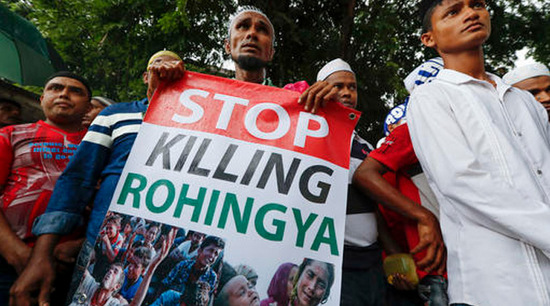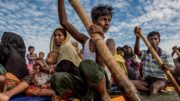There is an excellent article on the conflict between the Muslim Rohingyas and the Buddhist Burmese in a recent edition of the New English Review online magazine. It goes into the long and bloody history that the Rohingyas have brought to Burma over many years. It is a history of massacres of Buddhists and other crimes against them committed by those who various Islamic grievance mongers and the mainstream media tell us we should feel sorry for.
Now like the author if the quoted piece and like any other reasonable person I do not want to see these Rohingya, these Muslim squatters on Burmese soil, mistreated or killed. However, it is become pretty obvious that many Burmese for damned good reasons want these people back on Bangladeshi soil.
The potted history of the relationship between the Burmese and the Rohingya as set out by the author of the New English Review piece, Hugh Fitzgerald, is much more informative about the situation than we have had from our own mainstream media. It paints the Rohingya not as innocent victims of unjustified aggression but instead more honestly shows them as at least partial aggressors in the current and previous conflicts with Burma’s Buddhists. There is the distinct temptation to cry ‘taqiyya’ or lying to promote or protect Islam when one looks at the discrepancy between what is being claimed by Muslims and their fellow travellers about the plight of the Rohingya.
The way that Islamic groups, the Left and the mainstream media is whitewashing the crimes of the Rohingya is wrong and there is no doubt that although the Rohingya should not be wantonly murdered neither should Rohingya violence against Buddhists be ignored. The Rohingya, although subject to violence by Buddhists are not clean hands victims. The Rohingya have much Buddhist blood on their own hands and this needs to be taken into account when assessing the situation in Burma.
Here’s part of Mr Fittzgerald’s article and I must say it’s well worth taking the time to click through to the original article and to read it in full.
First of all Mr Fitzgerald took a moment to examine the media misinformation that is coming out about Burma and the criticism aimed at the Burmese State Counsellor Aung San Suu Kyi.
Mr Fitzgerald said:
Aung San Suu Kyi, the leader of Myanmar, is now all over the news, being taken to task for “not speaking out” against the mistreatment of the Rohingya, the Muslim minority in Myanmar, almost all of whom live in the western Rakhine State of Myanmar. 365,000 people have signed a petition demanding she be stripped of her Nobel Prize for not speaking out and denouncing the Buddhists of Myanmar; in Pakistan, a country renowned for its humane treatment of minorities, her photograph has been publicly burned; Al Jazeera has denounced her, and so has that champion of justice Tariq Ramadan.
In the last month, the world media reports, 250,000 Rohingya have now fled the latest cycle of violence, that began with Rohingya attacks on the military in mid-August, for Bangladesh. In fact, Aung San Suu Kyi has spoken out, but not in the way that many expected. They wanted her to categorically denounce the Burmese military and to depict the Rohingya as entirely innocent victims of Buddhist attacks; this she has refused to do. She believes the story of the Rohingyas in Myanmar is more complicated than the outside world believes. She has noted that “fake news” about atrocities in Myanmar have been relied on by much of the world’s media. More than a few of the stories about the Rohingya have indeed been accompanied by photos purportedly showing the violence against them, but which, in fact, have turned out to be photos of other atrocities experienced by other peoples, having nothing to do with Myanmar. Even the BBC’s south-east Asia correspondent, Jonathan Head, concedes that “much of it [the photos, and the coverage] is wrong.” A closer look reveals that many of the pictures supposedly from Myanmar have come from other crises around the world, with one of those tweeted by Turkey’s Deputy Prime Minister Mehmet Simsek even dating back to the Rwandan genocide in 1994
The misuse of images from other incidents of violence in order to promote the idea of Rohingya victimhood is pretty worrying most of all because it is dishonest. Although some journalists are seeing through some of the more obvious attempts to pass off images of violence elswhere as violence against the Rohingya, many more do not seem to have done this and are continuing to promote the questionable ‘poor oppressed Rohingya’ narrative.
Mr Fitzgerald then went on to explain what has been happening in Burma over the last month or so since the violence in Burma started to catch the eye of the international public.
Mr Fitzgerald added:
Let’s refresh our memories of what has been going on in Myanmar this last month. All the news reports coming from Myanmar (Burma) tell the same story: tens of thousands of the Rohingya, a Muslim minority, have been fleeing into Bangladesh, to avoid the sudden upsurge in violence from both Burmese military and civilians. The Rohingya are presented as the innocent and long-suffering victims of “racist” Burmese Buddhists (Islam being, for propaganda purposes, a “race”). Only a handful of the reports mention, and only briefly, as if in passing, that the current violence began when, in mid-August, Rohingya fighters attacked 30 different police stations and an army base, as part of their campaign to stake their claim to Rakhine State, in western Myanmar, and showing themselves able “to strike terror in the hearts” of the Infidels to get it. The attacks left more than 70 dead, Muslims and Buddhists.
The Rohingyas unleashed still other attacks, and the Burmese army then retaliated, and the Rohingya continued to strike back during the last two weeks in August, and then there was more retaliation from the Buddhists. Many Rohingya have fled the retaliatory violence — a violence which they began — for Bangladesh, but it is their flight, and that retaliation by the Buddhists, which is getting almost all of the attention in the Western press, complete with photographs of victims of other conflicts who are presented as Rohingya (the “fake news” of which Aung San Suu Kyi complained), rather than what prompted it.
Seldom mentioned is that the August attack by the Rohingyas was preceded by a similar attack, last October, by the Rohingyas on the Burmese (Buddhist) police, and again, it was not their initial attack, but almost exclusively the retaliation by the Buddhist army, that was the focus of reports in the foreign press last fall. Reports of Rohingya villages being burnt down are reported uncritically. The Myanmar authorities have claimed that Islamic militants, having infiltrated Rohingya communities, have themselves been setting fire to houses in Muslim villages in order to get the world even more on their side. Instead of assuming these claims must be false, why not investigate them?
According to most of the world’s media, an unfathomable tragedy has been unfolding in Myanmar. The Buddhist majority, inflamed by rabble-rousing anti-Muslim monks, has been persecuting, killing, even massacring, members of the entirely inoffensive Muslim Rohingya minority in the western state of Rakhine (formerly, and in some places still, known as “Arakan”). An example of this hysterical coverage can be found in a report from, unsurprisingly, the pro-Muslim Guardian. It describes a sinister senior monk, Shin Parathu, who is repeatedly accused by the Guardian of “stoking religious hatred across Burma. His paranoia and fear, muddled with racist stereotypes and unfounded rumors, have helped to incite violence and spread disinformation.” One might note that no examples of these “racist stereotypes” are ever given. Could it be that the “stereotype” that this monk is accused of spreading has to do with depicting Muslims as intent on Jihad in the path of Allah, unwilling and even unable to integrate into a Buddhist society, and with a history, going back to 1942, of violence against Buddhists, that is the Rakhine people of Arakan State, and even attempting to join part of East Pakistan, and through the late 1950s, and in the 1970s, and again in the 1990s, conducting a low-level insurrection against the Burmese state — all of which is true?
And while the Guardian insists that the Rohingya are never the instigators of violence, the policemen they attacked without warning and nine of whom they murdered last October, and the people they killed in 31 coordinated attacks in mid-August, and those Buddhists they have killed since, might beg to differ. The Western press remains resolutely unsympathetic to the Buddhists of Myanmar, unwilling to find out why those Buddhists might have reason to be alarmed.
Read the rest of this excellent and highly informative piece via the link below:
http://www.newenglishreview.org/blog_direct_link.cfm?blog_id=66591






Go to the BBC iPlayer and look for the “Jeremy Vine” programme from Weds Sept 6th and Fast Forward to 1.46 to 1.50 where he uncritically allows Daily Mail “journalist” Peter Oborne to rant and rave about Myanmar without ever querying a single detail, or commenting that there may be two sides to this story.
According to Oborne’s account, Al-Qaeda and jihadis are just “ordinary muslims” and he appears to imply that they have a perfect right to turn to terrorism, “because the West doesn’t give a damn about ordinary muslims”. (Quite how already flooding the Western world with muslims counts as “not giving a damn” he doesn’t – of course – explain, it doesn’t suit his agenda of importing still more….)
Next he goes on to claim that muslim minority groups are persecuted everywhere – the Southern Philippines, “occupied Kashmir”, Gaza, the West Bank – and that muslim women’s babies are being taken away and killed in an attempt to control the muslim population, that the Burmese army are gang-raping muslim women etc etc.
Has anyone ever heard a squeak from Oborne and the BBC about muslims gang-raping women and little girls across Europe ? Where is all the indignation and accusations of government indifference when it’s really merited ?